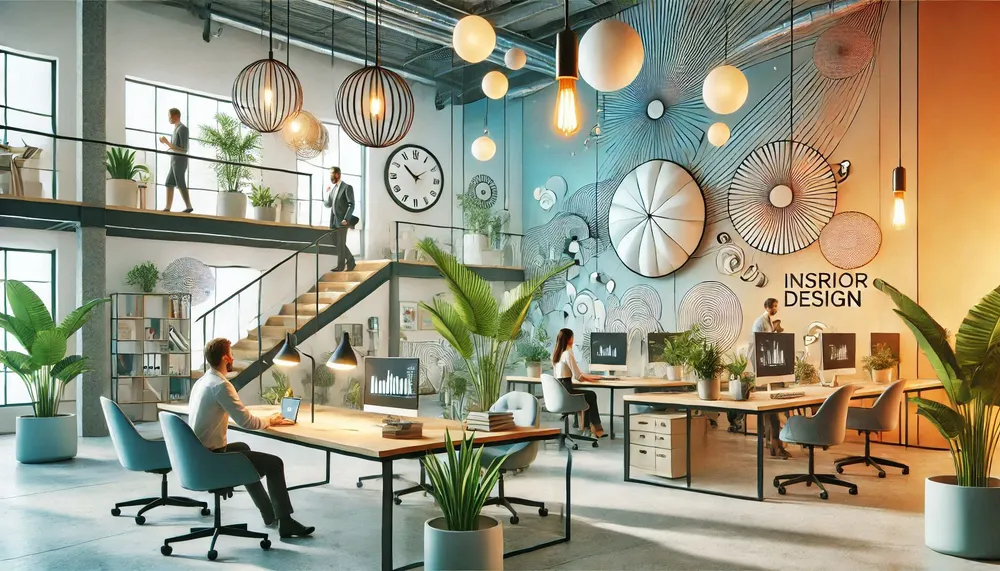How Interior Design Can Boost Workplace Productivity?
Good interior design makes workplaces comfortable and pleasant. It helps people work better by improving their mood and focus. The right design can make a space organized, reduce stress, and increase energy. Small changes like better lighting, colors, and furniture can make a big difference in how people feel and perform.
Ways Interior Design Boosts Productivity
Improved Lighting
- Good lighting helps people see clearly.
- It reduces eye strain and tiredness.
- Natural light makes people feel fresh and happy.
- Bright spaces improve focus and energy.
- Dim lighting can make people sleepy and slow.
- Use LED lights for a steady and soft glow.
- Avoid harsh lights that hurt the eyes.
- Desk lamps can help with detailed tasks.
- Place workstations near windows for sunlight.
- Professional interior designers in Ghaziabad creates a positive work atmosphere.
Comfortable Furniture
- Comfortable furniture helps people work better.
- Ergonomic chairs support the back and neck.
- Adjustable chairs fit people of different heights.
- Desks should be the right height for typing.
- A good posture reduces pain and tiredness.
- Soft cushions add extra comfort.
- Standing desks can reduce long sitting hours.
- Footrests help keep feet relaxed.
- Proper furniture prevents health problems like back pain.
- Comfortable furniture makes employees feel happy and focused.
Organized Spaces
- An organized space helps people work faster.
- Keep desks clean and free of clutter.
- Use drawers to store small items.
- Shelves help organize files and books.
- Label items to find them easily.
- A tidy space reduces stress and confusion.
- Avoid keeping too many things on the desk.
- Use cable organizers to manage wires.
- Keep frequently used items within reach.
- Organized spaces make work smoother and save time.
Natural Elements
- Natural elements make workplaces calm and happy.
- Add plants to the office for fresh air.
- Plants reduce stress and improve mood.
- Natural light helps people feel fresh and active.
- Large windows let in sunlight.
- Wooden furniture adds a warm and natural feel.
- Green walls or small gardens make spaces lively.
- Water features, like small fountains, are calming.
- Natural colors, like green and brown, create a peaceful vibe.
- These elements help people focus and stay relaxed.
Color Psychology
- Colors affect how people feel and work.
- Bright colors, like yellow, boost energy and creativity.
- Blue helps people focus and stay calm.
- Green reduces stress and makes eyes feel relaxed.
- Soft colors, like beige, create a peaceful space.
- Avoid very dark colors that feel dull or heavy.
- Use bold colors for accents, like walls or decorations.
- Match colors to the type of work being done.
- Bright colors work well in creative spaces.
- Calm colors are better for focused tasks.
Quiet Zones
- Quiet zones are spaces for focused work.
- They help people work without distractions.
- Noise makes it hard to concentrate.
- Quiet zones reduce stress and improve thinking.
- Use soundproof walls to block noise.
- Keep these areas away from busy spaces.
- Add soft carpets to absorb sound.
- Use noise-canceling headphones if needed.
- Provide comfortable chairs and desks in quiet zones.
- Quiet zones help employees finish tasks faster.
Collaboration Areas
- Collaboration areas are for team work.
- They help people share ideas and solve problems.
- Use open spaces to encourage talking.
- Round tables are good for group discussions.
- Comfortable chairs make people feel relaxed.
- Provide whiteboards or flip charts for brainstorming.
- Add colorful decorations to make the space inviting.
- Keep the area quiet but open for conversation.
- These spaces help improve teamwork.
- Collaboration areas make work fun and creative.
Temperature Control
- A comfortable temperature helps people work better.
- Too hot or too cold can distract people.
- Set the room temperature between 68-72°F (20-22°C).
- Use fans or air conditioning in hot weather.
- Use heaters when it’s cold.
- Employees should be able to adjust the temperature.
- Comfortable temperatures help people focus.
- Too much heat can make people tired.
- Cold temperatures can make people feel stiff.
- Proper temperature control keeps employees happy and productive.
Break Areas
- Break areas help employees relax.
- They need space to rest during the day.
- Comfortable chairs and tables are important.
- Add snacks or drinks for refreshment.
- A cozy environment helps recharge energy.
- Use soft lighting and calm colors.
- Break areas should be separate from work zones.
- Employees can talk or take a nap.
- Relaxing areas reduce stress and increase focus.
- Taking breaks helps people work better after.
Personalization
- Personalizing workspaces by an architectural service provider in Wave City makes people feel at home.
- Employees can add their own decorations.
- Pictures, plants, and personal items create comfort.
- It helps people feel more connected to their work.
- Personal spaces can boost happiness and creativity.
- It shows employees are valued and trusted.
- Personalizing a desk can improve focus and mood.
- Employees will feel more motivated.
- Allowing small changes makes the workspace feel unique.
- Personalization can help reduce stress and increase productivity.




